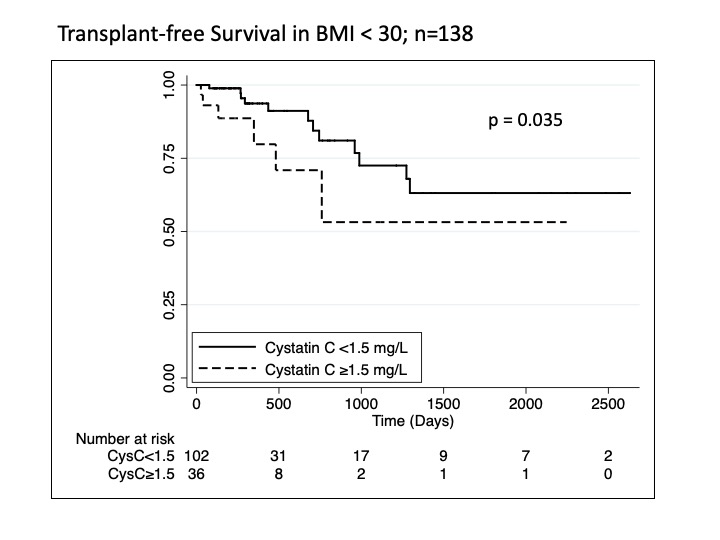Serum Cystatin C Predicts Kidney-Related Outcomes and Transplant-Free Survival in Patients with End-Stage Liver Disease and Low Body Mass Index
1Internal Medicine, Baylor Scott & White University Medical Center, Dallas, TX, 2University of Arkansas for Medical Sciences, Little Rock, AR, 3Department of Medicine, Division of Gastroenterology, Hepatology, and Nutrition, Center for Liver Diseases, Pittsburgh Liver Research Center, University of Pittsburgh Medical Center, Pittsburgh, PA, 4Baylor Simmons Transplant Institute, Dallas, TX, 5Baylor Simmons Transplant Institute, Fort Worth, TX
Meeting: 2020 American Transplant Congress
Abstract number: C-140
Keywords: Liver transplantation, Renal dysfunction, Survival, Weight
Session Information
Session Name: Poster Session C: Liver - Kidney Issues in Liver Transplantation
Session Type: Poster Session
Date: Saturday, May 30, 2020
Session Time: 3:15pm-4:00pm
 Presentation Time: 3:30pm-4:00pm
Presentation Time: 3:30pm-4:00pm
Location: Virtual
*Purpose: Liver transplant (LT) candidates with sarcopenia are disadvantaged by creatinine-based assessment of renal function as creatinine overestimates glomerular filtration rate (GFR). Low body mass index (BMI) may be a surrogate for decreased skeletal muscle mass in end-stage liver disease (ESLD). Serum cystatin C (CysC) can estimate GFR and is not influenced by sarcopenia.
*Methods: Two-center prospective cohort study of LT candidates with CysC obtained at the time of LT evaluation. Clinical events including need for hemodialysis (HD), simultaneous liver-kidney transplant (SLK), and transplant-free survival were assessed.
*Results: Of 246 LT candidates, 36% had hepatitis C, 21% alcoholic liver disease, and 20% fatty liver/cryptogenic; 54 (22%) had BMI <25 and 138 (56%) had BMI <30. 161 patients (66%) underwent transplantation after median 6.6 months with 146 (59%) LT and 15 (6%) SLK; 23 (9%) required pre-LT HD and 40 (16%) died without LT. Within the subset with BMI <30 (n=138), increased CysC was associated with need for pre-LT HD (ROC AUC 0.83; 0.68, 0.98) with CysC ≥1.5 mg/L as an optimal threshold (sensitivity 80.0%, specificity 80.5%). Likewise, increased CysC was associated with SLK in BMI <30 (ROC AUC 0.88; 0.71, 1.00) with CysC ≥1.8 mg/L as an optimal threshold (sensitivity 90.9%, specificity 90.6%). The presence of ascites was associated with decreased survival in patients with BMI <30 (p=0.04), but not BMI ≥30 (p=NS). When stratifying by ascites and CysC, patients with both ascites and CysC ≥1.5 mg/L had the poorest survival among the full cohort (n=246; p=0.003) and in BMI <30 (n=138; p=0.04). In patients with BMI <30, CysC ≥1.5 mg/L predicted survival (p=0.04), yet creatinine was not predictive at multiple thresholds (p=NS).
*Conclusions: CysC predicts pre-transplant HD, SLK, and transplant-free survival in LT candidates, particularly in lower BMI groups. The presence of ascites plus elevated CysC is associated with decreased survival, including those with low BMI. CysC may be an alternative biomarker to creatinine in estimating renal function in sarcopenic patients.
To cite this abstract in AMA style:
Shankar N, Duarte-Rojo A, Asrani SK, Trotter JF, Klintmalm GB, Fischbach BV, Gonzalez SA. Serum Cystatin C Predicts Kidney-Related Outcomes and Transplant-Free Survival in Patients with End-Stage Liver Disease and Low Body Mass Index [abstract]. Am J Transplant. 2020; 20 (suppl 3). https://atcmeetingabstracts.com/abstract/serum-cystatin-c-predicts-kidney-related-outcomes-and-transplant-free-survival-in-patients-with-end-stage-liver-disease-and-low-body-mass-index/. Accessed July 14, 2025.« Back to 2020 American Transplant Congress

